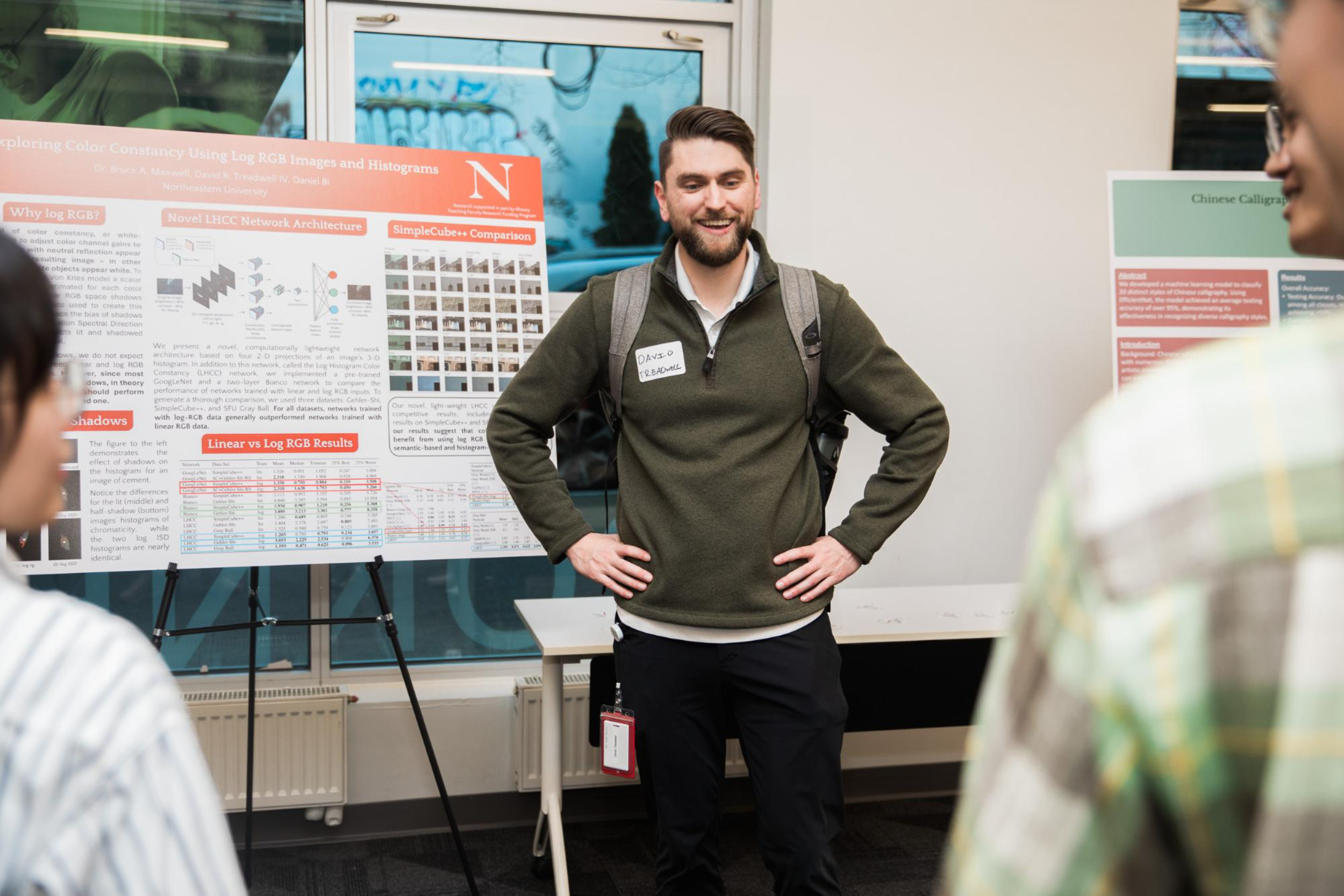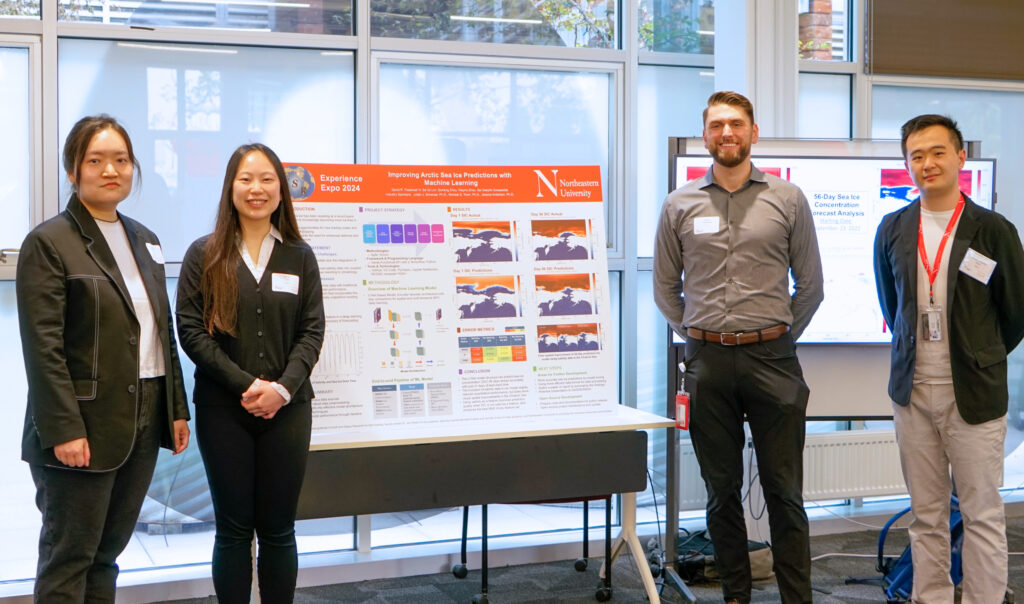David Treadwell’s Journey from Finance to Environmental AI at Northeastern in Seattle

If you went back in time and asked David Treadwell what he was going to be in five years, “computer vision and environmental researcher” would not have made the list. It wasn’t that he’d written it off – he simply hadn’t considered it at all. But as he prepares to graduate in May and join the computer vision and environmental research industry, he’s deeply grateful to three specific experiential learning opportunities at Northeastern University in Seattle for introducing him to a field he loves.
Before beginning his Master of Science in Computer Science, Treadwell was a full-time financial data analyst with a bachelor’s in business and political science.
“My job was to be a true expert at Excel, and part of that meant learning how to use Visual Basic for Applications, the back-end programming language of Excel,” Treadwell said. “It’s not my favorite language now that I’ve worked with a couple others, but it got me started. I loved the process of figuring out the problems and being able to automate something.”
So, Treadwell decided to learn more. When the Certificate of Computer Science Fundamentals from Seattle University only fueled his interest, Treadwell enrolled in the MS in Computer Science from Khoury College of Computer Sciences at Northeastern University in Seattle. He was drawn to the school’s focus on experiential learning.
Treadwell’s first significant experiential learning opportunity came in April of 2024, when he joined a hackathon focused on enhancing Indigenous communities’ fire preparedness, jointly hosted by Northeastern’s Seattle and Vancouver campuses. One of the hackathon’s industry partners had an algorithm to classify terrains in satellite images, but the algorithm couldn’t tell forests from other vegetation. Detecting forests is obviously important for detecting forest fires, so Treadwell developed that capability.
“The biggest reward was seeing that I can put the things I’m learning in class into a project outside of class,” Treadwell said. “I relied on many principles and techniques from my computer vision class, and seeing that not only could I figure it out, but everybody thought it would be useful – that was really rewarding.”
The paper that Treadwell wrote – the first one he’d ever submitted to a conference – won a best paper award at the Institute of Electrical and Electronics Engineers’ Pacific Rim Conference on Communications, Computers, and Signal Processing (PACRIM) ’24.
By then, Treadwell was fired up about computer vision and the environment. So, when he got the opportunity to join a Northeastern Experience Expo team creating a deep network to predict arctic sea ice concentrations a couple months later, he jumped on it. The Experience Expo is a unique opportunity for graduate students across different colleges to create an interdisciplinary project under the supervision of an industry mentor – in this case, the nonprofit institute Earth and Space Research.
Over the course of their eight weeks, Treadwell and his groupmates – two other computer scientists, one data engineer, and one project manager – investigated existing models’ strengths and shortcomings, like how many fail to account for the salt in ocean water affecting the temperature at which ice freezes. They used an existing model as a jumping-off point to create a novel U-Net deep learning model that turns three weeks of input data into eight weeks of accurate sea ice concentration predictions.
“The eight-week window was informed by a general climate perspective; the two real applications of that knowledge are planning shipping routes and defense,” Treadwell explained. “Learning how to do a data science project with a lot of moving parts, while also learning a new field – sea ice and oceanography – was a huge challenge, but I loved it. It feels really good to know that there’s potentially some serious benefit to the earth; having a deeper meaning is definitely rewarding.”
Treadwell and two of his groupmates later took co-ops with Earth and Space Research, refining the model through the fall of 2024.

Finally, Treadwell was impacted by his work with professor Bruce Maxwell on color constancy and automatic white balancing. In a white room lit by an orange lamp, a human will understand the walls look orange because of the light, not the paint. A computer will just see the color orange, though, and will face a challenge identifying the color of the light source, making it tough to automatically correct a picture of the room so that the walls look white.
This project let Treadwell polish his pure computer vision skills. He developed a convolutional neural network based on multiple 2D projections of the 3D histograms of the colors red, green, and blue that represent images, to then automatically color-balance those images and make their white materials appear white.
“We’re trying to hit a balance between simplicity, speed, and accuracy. Many times in deep learning, by going deeper, you get better results, but one of the main cases for white balancing is phone pictures,” Treadwell said. “It has to happen really quickly; automatic white balancing should be seamless from the user’s perspective.”
“David has been an amazing research assistant this year. He has progressed to the point where he is taking the lead on experiments and ideas about how to proceed,” Maxwell added. “He has become one of the best research assistants I’ve had the pleasure of working with, and I think he may have caught the research bug.”
Treadwell agrees. He’s planning to continue working in computer vision and environmental research after graduating in the spring of 2025.
“I feel lucky that Northeastern’s emphasis on experiential learning ended up being true for me. I had a lot of opportunities to do projects outside the classroom with real partners and real research topics, and that completely shaped my career path and uncovered these passions,” Treadwell said. “I’m so thankful I ended up at Northeastern, because it would have been hard to get that without all the experiential learning projects, and now my whole career path has been shaped by it.”
By Madelaine Millar




